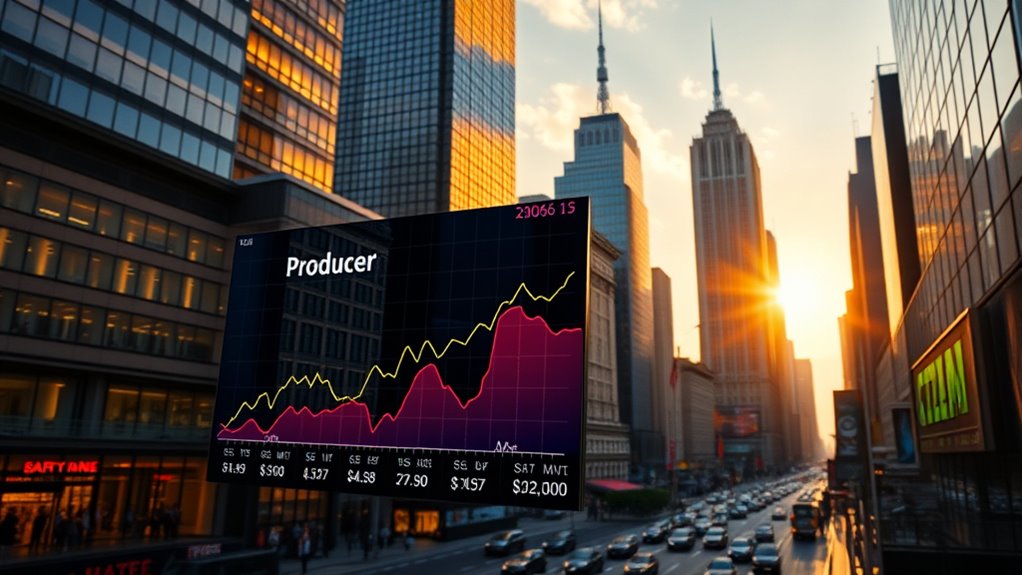When producer prices rise, it signals higher inflation expectations, which can make the dollar strengthen. Investors see increasing costs at the production level as a sign of a robust economy or upcoming inflation, prompting them to buy more dollars. This increased demand lifts the currency’s value. If you want to understand how these price signals influence currency movements and what factors drive these changes, keep exploring the details behind producer price growth and its effects.
Key Takeaways
- Rising producer prices indicate higher input costs, leading investors to anticipate increased inflation.
- Expectations of future inflation can prompt the Federal Reserve to raise interest rates, strengthening the dollar.
- Higher PPI signals economic resilience, attracting foreign investment and boosting the dollar’s value.
- Elevated producer price growth can cause the dollar to appreciate as markets price in inflation risks.
- A strong dollar reduces import prices, which can influence producer price trends and reinforce currency strength.

Producer price growth measures how the prices domestic producers receive for their output change over time. This index tracks inflation by observing variations in selling prices before they reach consumers. It’s a crucial economic indicator because it often predicts future consumer price inflation, giving you an early signal of potential shifts in the economy. When producer prices rise, it suggests that the costs of goods and services at the production level are increasing, which can eventually lead to higher prices at the retail level. Conversely, falling producer prices may indicate easing inflation pressures.
The calculation of the Producer Price Index (PPI) involves a modified Laspeyres formula, which compares current revenues from sales to those in a base period. This method uses weighted average price changes, where weights are based on the quantities and prices from the base period. The Bureau of Labor Statistics (BLS) gathers extensive data monthly from over 16,000 establishments and about 64,000 price quotations, ensuring that the index reflects a broad and accurate picture of producer prices across multiple sectors. These sectoral weights are determined by the revenue generated by different goods and services, emphasizing the importance of high-revenue items in influencing overall trends.
Your focus should be on the index’s scope, which covers domestically produced goods and services across sectors like manufacturing, mining, agriculture, forestry, gas, electricity, waste, and scrap materials. While imports are excluded, intra-company transfers and military-specific domestic production are incorporated. Significantly, the PPI measures prices from the seller’s perspective, contrasting with consumer-focused indices like the CPI. This focus on the transaction price at the point of booking captures changes in the industrial output and related services, reflecting how prices evolve before reaching consumers.
When producer prices increase, it can signal rising input costs and supply chain pressures, often driven by commodity price movements, energy costs, or labor expenses. Such growth tends to precede consumer inflation and can influence monetary policy decisions, as central banks monitor these trends to adjust interest rates accordingly. During recent years, especially amid the COVID-19 pandemic, PPI spiked to decade-high levels, driven by supply disruptions, demand shifts, and rising raw material costs. These fluctuations highlight how global economic events and commodity markets directly impact producer prices.
Sector-specific movements also matter. Manufacturing, energy, agriculture, and mining show distinct price trends that influence overall PPI changes. As producer prices grow, they can push the dollar upward because investors interpret sustained inflation signals as a need for higher interest rates, which attract foreign capital. This dynamic underscores the importance of producer price growth as a driver of currency strength, reflecting expectations of future inflation and economic resilience. Additionally, understanding the impact of inflation is crucial for investors navigating these economic signals.
Frequently Asked Questions
How Does Producer Price Growth Impact Consumer Inflation?
When producer prices rise, you can expect consumer inflation to follow, but with a delay. As input costs increase, businesses often pass these costs onto you through higher retail prices. If the trend continues, you’ll see prices for goods and services go up over time. Keep in mind, tariffs and supply chain issues can accelerate this process, making inflation more noticeable in everyday purchases.
Which Industries Are Most Affected by Rising Producer Prices?
You’ll find metals and mining most affected by rising producer prices, as supply constraints and tariffs push costs higher, boosting metal prices like copper and lithium. The energy sector also faces increased costs due to higher extraction prices, impacting profitability. Conversely, food and beverages experience margin pressures but less direct impact on production costs. As a result, these industries must navigate cost increases, affecting pricing strategies and profit margins.
What Is the Historical Correlation Between PPI and Dollar Strength?
Think of the relationship between PPI and dollar strength as a dance that changes steps over time. Historically, they tend to move in opposite directions—when the dollar strengthens, PPI usually drops, and vice versa. But recent shifts show they sometimes move together, especially during specific shocks or structural changes. Overall, the correlation is complex, influenced by external factors, making their relationship a dynamic and unpredictable dance.
How Quickly Do Producer Price Changes Influence Currency Markets?
You’ll notice that producer price changes can influence currency markets within hours to weeks. Right after the PPI release, traders react quickly, causing immediate volatility. Over time, the impact unfolds as inflation expectations and monetary policy outlooks adjust, often taking several weeks. Larger surprises or supply chain issues tend to accelerate this process, especially in high-inflation periods, making the market more responsive and dynamic in a shorter timeframe.
Are There Geopolitical Factors Influencing Recent Producer Price Trends?
Yes, geopolitical factors are influencing recent producer price trends. You’ll notice regional conflicts like the Russia-Ukraine war and Israel-Hamas tensions causing energy and food prices to surge, which raises input costs for producers. Additionally, trade policies, tariffs, and trade disruptions due to geopolitical tensions increase costs and uncertainty. These factors drive up producer prices globally, especially in energy and commodity sectors, contributing to inflation pressures and affecting overall economic stability.
Conclusion
As producer prices continue to rise, the dollar’s ascent hints at more than just numbers—it’s a sign of shifting economic currents you can’t ignore. Will this momentum sustain, or will unseen forces pull the rug out from underneath? Stay alert, because what happens next could reshape your financial landscape in ways you never saw coming. The next move isn’t just about prices; it’s about what’s lurking beneath the surface, waiting to be revealed.









